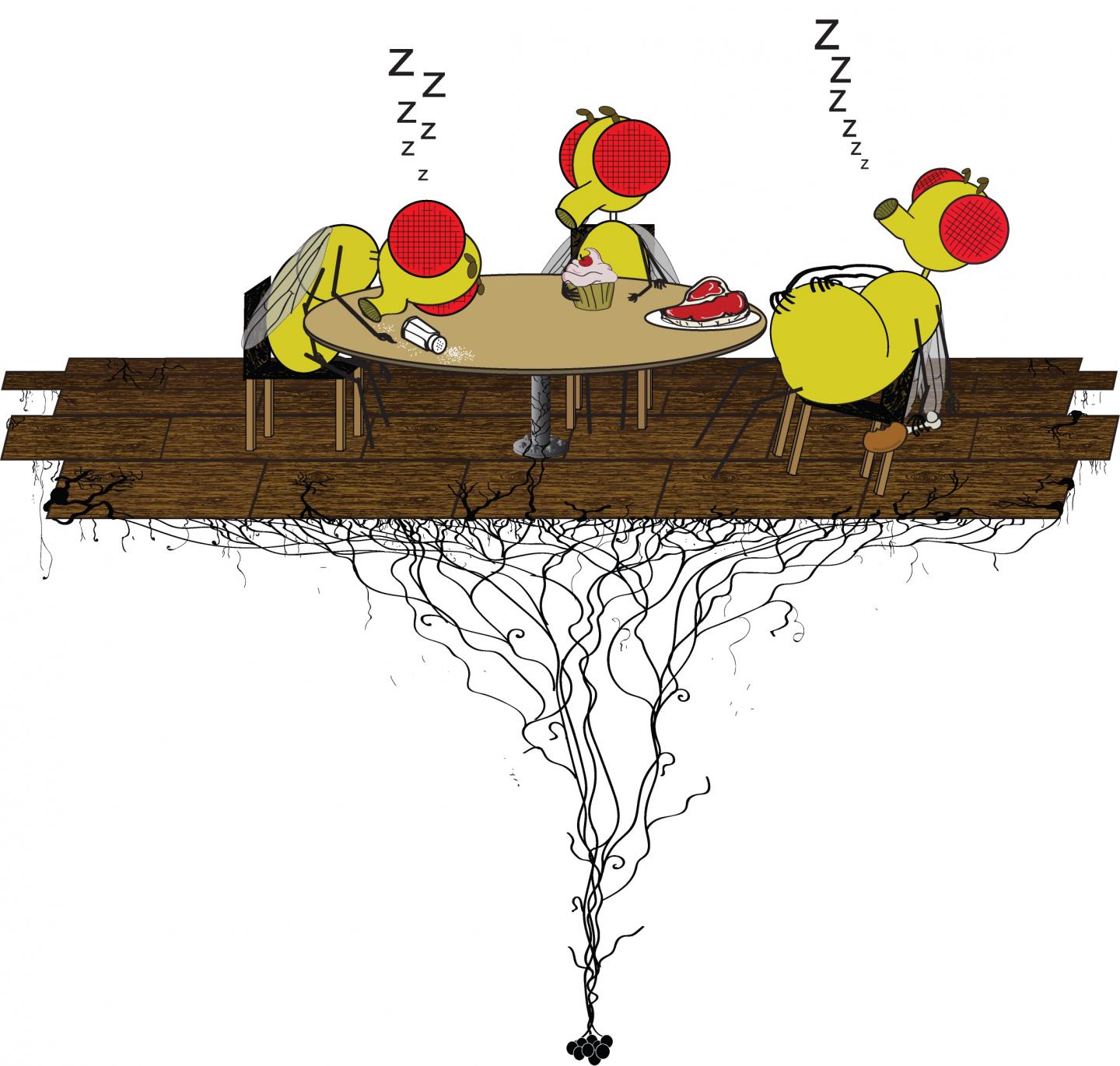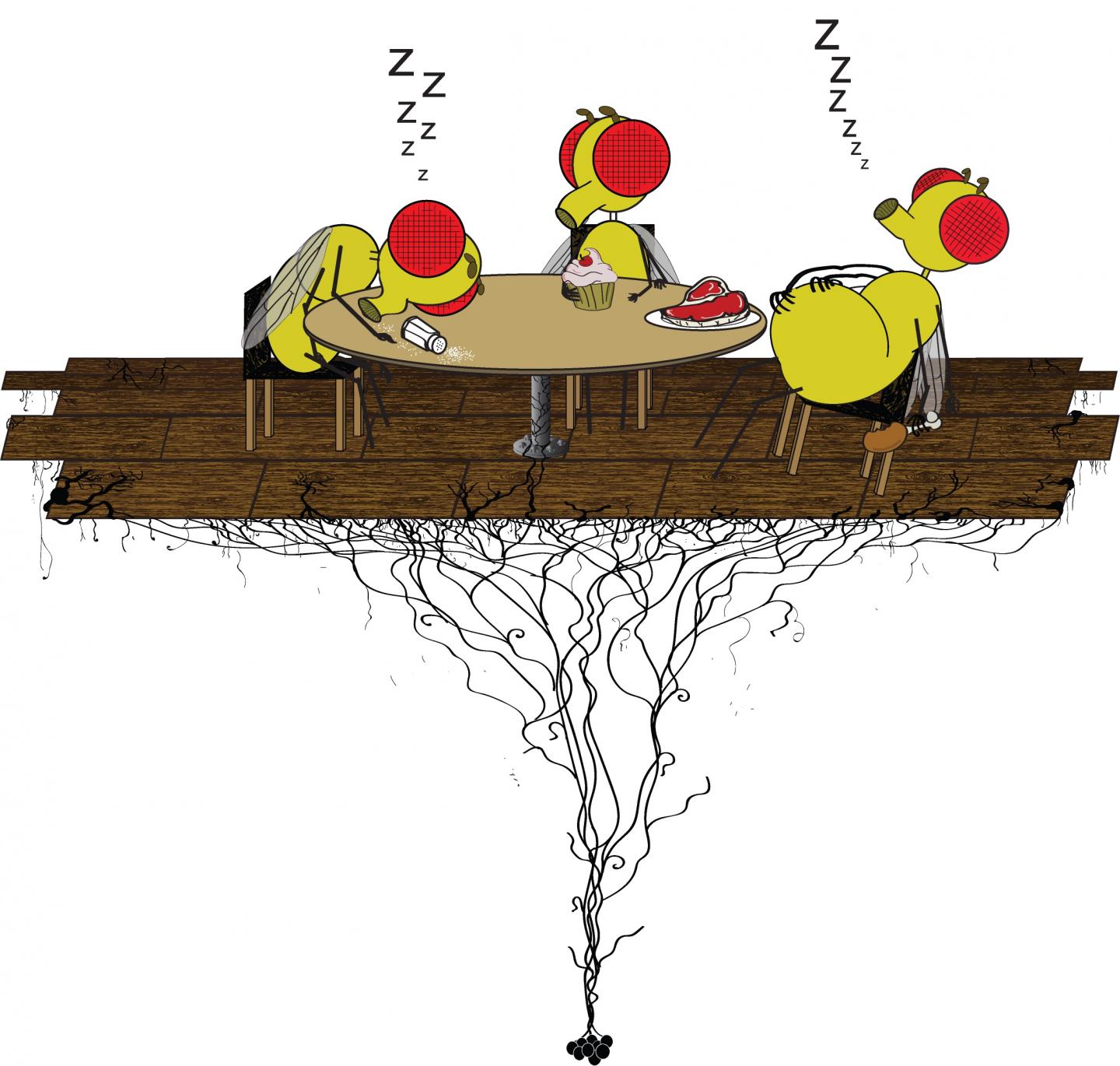
Credit: Keith Murphy
Sleepiness after a large meal is something we all experience, and new research with fruit flies suggests higher protein and salt content in our food, as well as the volume consumed, can lead to longer naps.
Writing in the journal eLife, scientists from The Scripps Research Institute, US, have for the first time found a way to study 'food comas' in the fruit fly Drosophila melanogaster and explained some of the causes behind this phenomenon.
They created a system that can measure both the sleep and feeding behaviors of individual fruit flies and discovered that, in much the same way as humans, the animals sleep for longer periods following larger meals. Further studies also revealed that certain types of food can promote post-meal sleep.
"In Drosophila, there is a well-documented interaction between sleep and metabolism, whereby flies suppress sleep or increase their activity when starved," says senior author William Ja, PhD, Associate Professor in the Department of Metabolism and Aging at Scripps Florida. "However, the acute effects of food consumption on sleep have not yet been tested, largely because there was no system available to do so."
To better understand this relationship, Ja and his team created the Activity Recording CAFE (ARC), the first system for flies that enables visual tracking of food consumption and animal motion. Recordings of fruit flies' behavior from this system reveal that, after eating a meal, the animals sleep more before returning to a normal state of wakefulness. The sleep period generally lasts around 20 to 40 minutes, with flies that eat larger portions generally sleeping more.
To determine if individual nutrients could modulate post-meal sleep, the team gave the flies food consisting of protein, salt or sugar. They found that only protein and salt were effectors of post-meal sleep, suggesting that this form of sleep can indeed be regulated by specific food types.
"We next sought to identify a neuronal mechanism by which feeding drives post-meal sleep," explains first author Keith Murphy. "By using genetic tools to turn neurons on and off in the fly brain, we were surprised to find a number of circuits that play a role in controlling this behavior."
A previous study has shown that leucokinin (Lk) neurons are involved in meal-size regulation, indicating that this system acts rapidly during feeding to signal a behavioral shift. Building on this work, the authors of the current study demonstrate that the Lk system plays a role in post-meal sleep.
"A subset of leucokinin receptor (Lkr) neurons was necessary to initiate post-meal sleep in the presence of protein specifically," Murphy says. "While we expected that flies defective in protein sensing would experience post-meal sleep in a similar way to those fed only sucrose, we found instead that they had a waking response. Our analysis suggests that ingested protein promotes both sleep and wakefulness, and that the wakefulness is counterbalanced by Lkr neuronal activity."
They also found that other brain circuits are sensitive to the fruit fly's internal clock, reducing post-meal sleepiness only around dusk. Taking these results together, the team concludes that post-meal sleepiness can be regulated in a number of different ways in flies and humans alike.
"The ARC provides a starting point for future studies aimed at uncovering the exact genes and circuits that enable meal size, protein and salt to drive sleep," Ja adds. "As sleep is a vulnerable state for animals in nature, it will be interesting to discover why post-meal naps are necessary."
###
Reference
The paper 'Postprandial sleep mechanics in Drosophila' can be freely accessed online at http://dx.doi.org/10.7554/eLife.19334. Contents, including text, figures, and data, are free to reuse under a CC BY 4.0 license.
Media contacts
Emily Packer, eLife
[email protected]
01223 855373
Eric Sauter
[email protected]
(267) 337-3859
About eLife
eLife is a unique collaboration between the funders and practitioners of research to improve the way important research is selected, presented, and shared. eLife publishes outstanding works across the life sciences and biomedicine — from basic biological research to applied, translational, and clinical studies. All papers are selected by active scientists in the research community. Decisions and responses are agreed by the reviewers and consolidated by the Reviewing Editor into a single, clear set of instructions for authors, removing the need for laborious cycles of revision and allowing authors to publish their findings quickly. eLife is supported by the Howard Hughes Medical Institute, the Max Planck Society, and the Wellcome Trust. Learn more at elifesciences.org.
Media Contact
Emily Packer
[email protected]
01-223-855-373
@elife
http://www.elifesciences.org
############
Story Source: Materials provided by Scienmag




